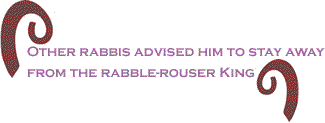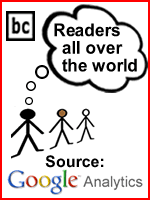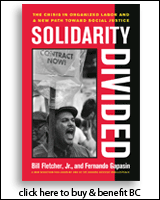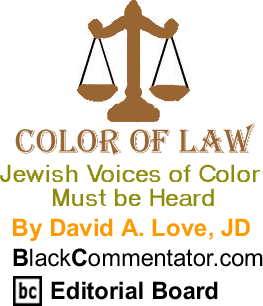
|
||||||||||||||||||||||
|
||||
 |
||||
As
we enter this holiday season, Jews around the world will celebrate
Hanukah. And the global Jewish community is a diverse one, a multicultural
and multiracial assemblage, by no means monolithic, representing
millions of people throughout the world. Jews in China look like
other Chinese, while Jews in India resemble other Indians, as is
the case with the Igbo Jews of Nigeria and the Lemba of Southern
Africa, and so on. But like a faulty census that leaves out people and portrays an inaccurate picture of what is happening, the Jewish Diaspora is not counting all of its members. Part of the reason is that Jews of color are often held in suspicion, not viewed as real or authentic. The reality is that black and brown Jews always existed, and for thousands of years. Given the places where the stories in the ancient scriptures took place, what else could you expect? Yet, media images - including Charlton Heston�s portrayal of a blond-haired, blue-eyed Moses in The Ten Commandments - only serve to create confusion concerning race and Judaism. �Jews of color have been like Jerzy Kosinski�s The Painted Bird, a bird trying to reintegrate itself into its flock, but looks so different that the flock would turn itself on the painted bird, pecking on the painted bird until it falls to the ground,� said Rabbi Capers Funnye, head rabbi of the predominantly African-American Beth Shalom B�nai Zaken Ethiopian Hebrew Congregation in Chicago. The congregation was founded in 1918 by a rabbi from Bombay, India. Rabbi Funnye converted to Judaism, but his introduction to Judaism was through the lens of Africa. His congregation combines the usual Jewish prayers with gospel music and the beat of the drum. But that is ok, because that is what culture is all about. �Jewish practices are based on cultural adaptations, where people found themselves,� the rabbi notes. Although he is a rabbi with extensive knowledge and undeniable passion, Rabbi Funnye is asked if he is really a Jew. �For a Jew who don�t look like you, that question is offensive,� he responds.
The conference was refreshing in that it invited a discussion on subjects usually not covered in academia or the mainstream Jewish community. For example, there was a discussion on Rabbi Alysa Stanton, the first African-American woman ordained as a rabbi, and the first black rabbi to lead a majority white congregation. Stanton, whose congregation is in Greenville, NC, received death threats and required a police escort the day she was installed as rabbi. Another topic of discussion was Rabbi Abraham Joshua Heschel, that mythic symbol of black-Jewish cooperation who marched with Dr. Martin Luther King. Rabbi Heschel is a great source of pride for the Jewish community, yet he was marginalized during his life, and regarded as an oddball. Other rabbis advised him to stay away from the rabble-rouser King. And today, Heschel�s anti-racist, social justice message is defanged. Further, there was an examination of black-Jewish relations and the civil rights coalition, and the manner in which Jews benefited from civil rights in ways blacks could not; the focus by organizations such as the ADL on issues of Jewish authenticity and Minister Louis Farrakhan, when there are genocides taking place around the world; concepts of whiteness and blackness, and the ways in which the Jewish communities have negotiated race. Participants also tackled such weighty issues as black power, and the attempts to equate it with anti-Semitism; the disproportionate representation of neoconservative Jewish voices in American political discourse, and the use of white Ashkenazi Jewish voices as the authoritative voice against affirmative action. Included in the symposium was the inevitable discussion of Israel, and the ways in which some immigrants become �white� when they arrive in Israel, although they were not considered as such in their home countries. And of course, there is Israel�s occupation of Palestine. Rabbi Funnye, who works with the Palestinian-American community in Chicago, believes that Israel must do a better job of showing its own diversity. He also shed some light on African-American perceptions of the Israeli-Palestinian conflict. �Black people don�t say anything because they see the Palestinians as David, and Israel as Goliath,� Funnye concluded. �They don�t want to be called anti-Semites.�
BlackCommentator.com Editorial Board member, David A. Love, JD is a journalist and human rights advocate based in Philadelphia, and a contributor to The Huffington Post, theGrio, The Progressive Media Project, McClatchy-Tribune News Service, In These Times and Philadelphia Independent Media Center. He also blogs at davidalove.com, NewsOne, Daily Kos, and Open Salon. Click here to contact Mr. Love. |
||||
 |
||||
If you would like to comment on this article, please do so below. There is a 400 character limit. You do not need a FaceBook account. Your comment will be posted here on BC instantly. Thanks. Entering your email address is not mandatory. You may also choose to enter only your first name and your location.
|
||||
Thank you very much for your readership. |
||||
| Any BlackCommentator.com article may be re-printed so long as it is re-printed in its entirety and full credit given to the author and www.BlackCommentator.com. If the re-print is on the Internet we additionally request a link back to the original piece on our Website. | ||||
| |
||||
| December 10 , 2009 Issue 354 |
| Executive Editor: Bill Fletcher, Jr. |
| Managing Editor: Nancy Littlefield |
| Publisher: Peter Gamble |
| Est. April 5, 2002 |
| Printer Friendly Version in resizeable plain text format |
 |
 |

|
 |
| |
| |

































 Rabbi
Funnye - who is also a member of the
Rabbi
Funnye - who is also a member of the 











